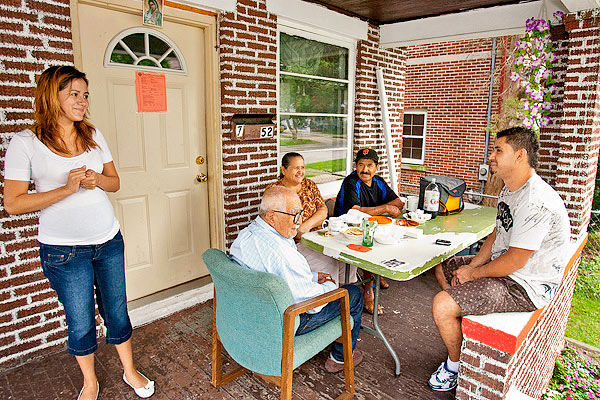
Chicago’s Latino Policy Forum has discerned a painful irony: Latino neighborhoods and suburbs have a heavy concentration of both over-crowded housing units and empty foreclosures. “We have these two phenomena happening concurrently,” said Juliana Gonzalez-Crussi, the forum’s policy and housing analyst, when we talked on Monday.
Add to that the fact that Latinos’ primary assets are more likely to be their homes than stocks or other investments, and Latinos wind up getting “the worst of a bad economy,” as the Pew Research Center put it in January.
In a blog post for the Metropolitan Planning Council earlier this month, Gonzalez-Crussi described the crosscurrents visible in Latino neighborhoods. “As one household is overcrowded,” she wrote, “its space stretched to accommodate extended family or friends who have fallen on hard times, the home next door sits vacant, its windows covered with plywood and its yard untended.”
During our conversation, Gonzalez-Crussi acknowledged that some overcrowding is due to cultural factors, such as Latinos’ taste for living in multigenerational homes and their tolerance for greater density. But these days, she pointed out, that overcrowding is intensified by the doubling-up that occurs after foreclosures or other recession-related housing losses.
With derelict foreclosures potentially pushing down the value of neighboring homes that are over-occupied, Latinos have a big stake in the recovery of the housing market. “Stabilizing these neighborhoods is important,” Gonzalez-Crussi insisted, adding that Latinos’ wealth is “plummeting.”
Approximately the same clash of currents is at play in the architect Jeanne Gang’s proposal for a new co-op-style housing type. It’s her contribution to an exploration of solutions to the housing crisis undertaken by the Museum of Modern Art in New York. Though Gang declined to be interviewed for this story, she told the Tribune’s Blair Kamin that there is a “housing mismatch” in Cicero, where moderate-income immigrants and foreclosures are present in big numbers. Gang envisions creating spaces that can flex with a household’s changes. You might, for instance, have a two-bedroom home to which you could add a third or fourth bedroom simply by buying more (inexpensive) shares of the cooperative that owns your building.
Gonzalez-Crussi endorsed the Gang idea in principle. “Housing that has been built for the [traditional] nuclear family doesn’t account for the changing composition of a household,” she said. But when we spoke earlier this week, she had not seen enough of Gang’s plan to say more.
But Gonzalez-Crussi fully supported Cook County’s new vacant property ordinance, which goes into effect this week. “The issue of empty [unmaintained] foreclosures with the potential to attract crime and decrease property values resonates across these communities,” she said. (I discussed the ordinance with WBEZ’s Tony Serabia and Natalie Moore on the station’s 848 program on Monday.)
The ordinance echoes one that’s already in place in Chicago and applies to unincorporated areas of the county, with incorporated suburbs able to opt in as well. “This provides an opportunity for municipalities that don’t have that type of infrastructure to adopt it,” Gonzalez-Crussi said. “Berwyn and Cicero have [vacant property] ordinances in some form, but Melrose Park doesn’t, and it has a large proportion of Latinos who can benefit from it [being adopted] there.”
Last summer, Gonzalez-Crussi and her organization’s executive director, Sylvia Puente, spoke to me about how Latinos frequently see homeownership as a sign of having made it. With a new study out this week that suggests Latinos’ share of the workforce (and thus, the home-buying or –renting population) will grow, it’s clear that solutions to the housing crisis—whether Gang’s visionary plan or market-based ones such as foreclosure-to-rental conversions—could help eliminate the too-empty/too-full phenomenon that the Latino Policy Forum has identified.
Photograph: Olga Lopez


